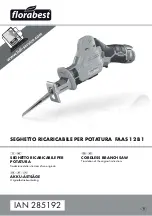
inattention while operating power tools may result in serious personal injury.
b)
Use personal protective equipment. Always wear eye protection.
Protective equipment such as a dust mask, non-skid safety shoes, hard hat, or
hearing protection used for appropriate conditions will reduce personal injuries.
c)
Prevent unintentional starting. Ensure the switch is in the off-position
before connecting to power source and/or battery pack, picking up or
carrying the tool.
energising power tools that have the switch on invites accidents.
d)
Remove any adjusting key or wrench before turning the power tool on.
A
wrench or a key left attached to a rotating part of the power tool may result in
personal injury.
e)
Do not overreach. Keep proper footing and balance at all times.
This
enables better control of the power tool in unexpected situations.
f)
Dress properly. Do not wear loose clothing or jewellery. Keep your
hair
and clothing
away from moving parts.
Loose clothes, jewellery or
long
hair can be caught in moving parts.
g)
If devices are provided for the connection of dust extraction and
collection facilities, ensure these are connected and properly used.
Use
of dust collection can reduce dust-related hazards.
h)
Do not let familiarity gained from frequent use of tools allow you to
become complacent and ignore tool safety principles.
A careless action
can cause severe injury within a fraction of a second.
4) POWER TOOL USE AND CARE
a)
Do not force the power tool. Use the correct power tool for your
application.
The correct power tool will do the job better and safer at the rate
for which it was designed.
b)
Do not use the power tool if the switch does not turn it on and off.
Any
power tool that cannot be controlled with the switch is dangerous and must be
repaired.
c)
Disconnect the plug from the power source and/or remove the battery
pack, if detachable, from the power tool before making any adjustments,
changing accessories, or storing power tools.
Such preventive safety
measures reduce the risk of starting the power tool accidentally.
d)
Store idle power tools out of the reach of children and do not allow
persons unfamiliar with the power tool or these instructions to operate
the power tool.
Power tools are dangerous in the hands of untrained users.
e)
Maintain power tools and accessories. Check for misalignment or
binding of moving parts, breakage of parts and any other condition that
may affect the power tool’s operation. If damaged, have the power tool
repaired before use.
Many accidents are caused by poorly maintained power
tools.
f)
Keep cutting tools sharp and clean.
Properly maintained cutting tools with
sharp cutting edges are less likely to bind and are easier to control.
g)
Use the power tool, accessories and tool bits etc. in accordance with
these instructions, taking into account the working conditions and the
work to be performed.
Use of the power tool for operations different from
those intended could result in a hazardous situation.
5)
SAFETY WARNINGS FOR RECIPROCATING SAW
The following information applies to professional users only but is good practice for all
users:
ADDITIONAL SAFETY WARNINGS FOR CONSTRUCTION DUST
The updated Control of Substances Hazardous to Health Regulations 1st October
2012 now also targets to reduce the risks associated with silica, wood and gypsum
dusts.
Construction workers are one of the at-risk groups within this because of the dust that
they breathe: silica dust is not just a nuisance; it is a real risk to your lungs!
Silica is a natural mineral present in large amounts in things like sand, sandstone and
granite. It is also commonly found in many construction materials such as concrete and
8









































